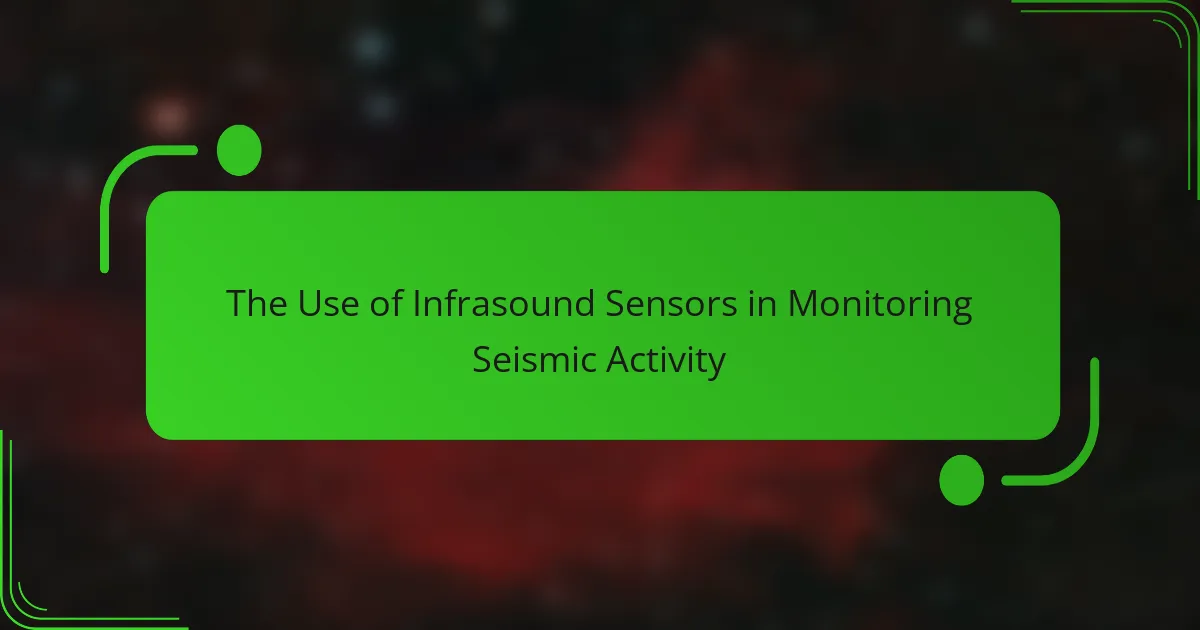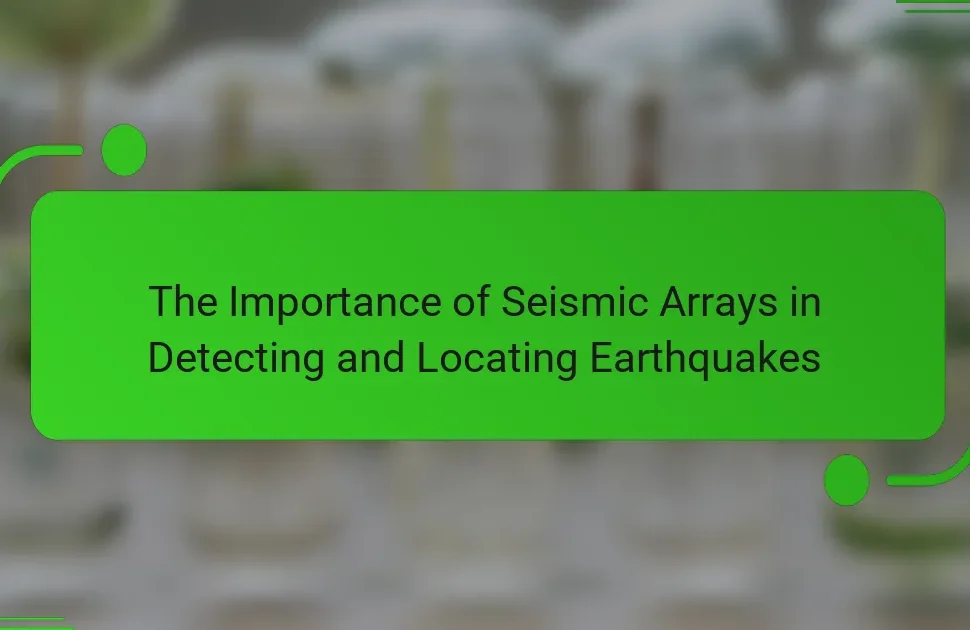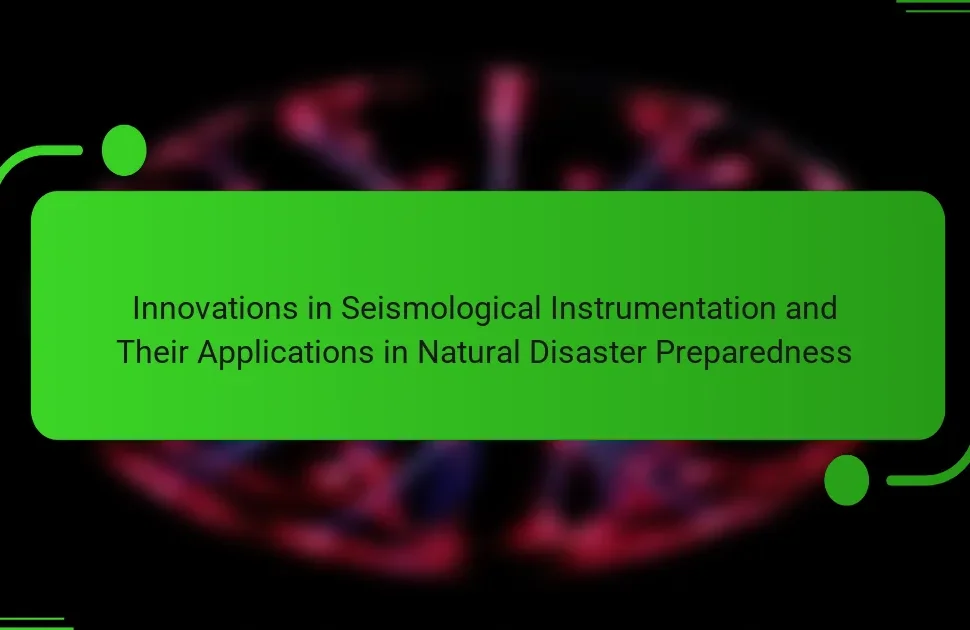Infrasound sensors are specialized devices designed to detect low-frequency sound waves that fall below the range of human hearing. These sensors are essential for seismic monitoring, as they capture vibrations generated by geological events such as earthquakes and volcanic eruptions, often providing early warnings before traditional seismic instruments can react. The strategic deployment of infrasound sensors in remote locations enhances their effectiveness in monitoring seismic activity, while advancements in technology promise improved sensitivity, real-time data analysis, and miniaturization for broader applications. Ongoing research and collaboration between institutions and industries aim to further enhance predictive capabilities and data sharing in the field of seismic monitoring.
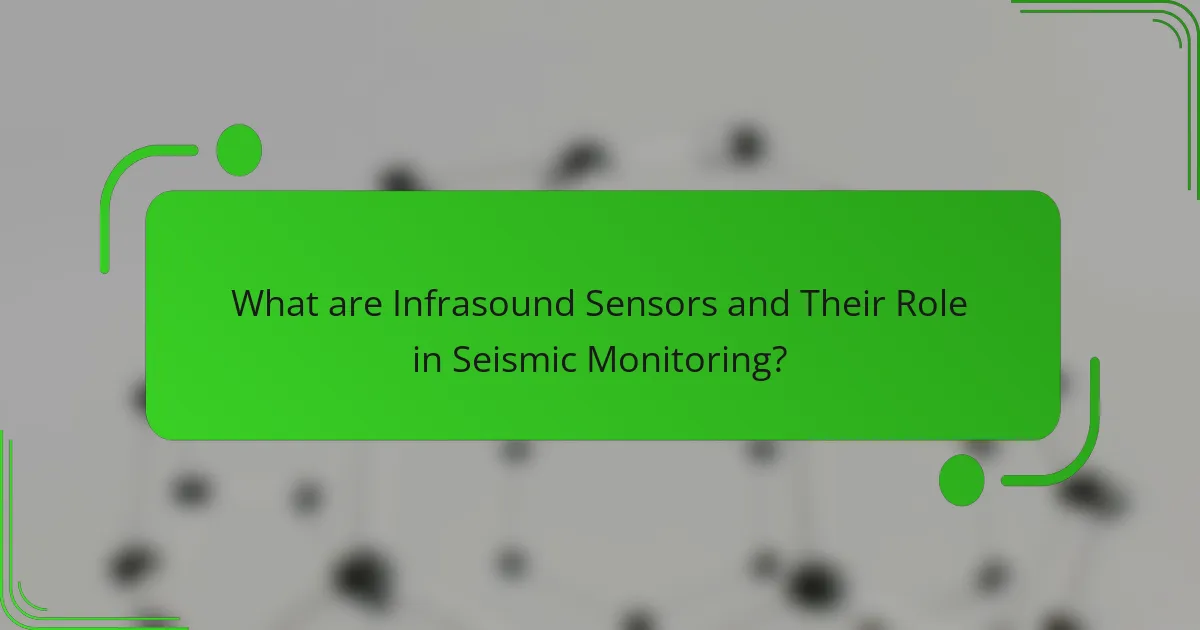
What are Infrasound Sensors and Their Role in Seismic Monitoring?
Infrasound sensors are devices that detect low-frequency sound waves below the range of human hearing. These sensors play a crucial role in seismic monitoring by capturing vibrations produced by geological events. They can detect distant seismic activities, such as earthquakes and volcanic eruptions, often before traditional seismic instruments. Infrasound waves travel long distances, making these sensors valuable for early warning systems. Research has shown that infrasound data can enhance the understanding of seismic events. For example, infrasound sensors can identify the location and magnitude of events with high accuracy. This capability aids in disaster preparedness and response efforts.
How do Infrasound Sensors detect seismic activity?
Infrasound sensors detect seismic activity by measuring low-frequency sound waves generated by geological events. These sensors are sensitive to frequencies below 20 Hz, which are often produced during earthquakes. When seismic activity occurs, it generates vibrations that travel through the earth and produce infrasound waves. Infrasound sensors capture these waves and convert them into electrical signals for analysis.
Research indicates that infrasound waves can travel long distances, allowing for detection even when the source is far from the sensor. Studies have shown that infrasound can provide early warning of seismic events, enhancing monitoring capabilities. For example, infrasound data has been used in conjunction with traditional seismic networks to improve accuracy in detecting and locating earthquakes.
What physical principles govern the operation of Infrasound Sensors?
Infrasound sensors operate based on the principles of sound wave propagation and pressure variations. These sensors detect low-frequency sound waves, typically below 20 Hz. They utilize microphones or specialized transducers to convert infrasound waves into electrical signals. The sensitivity of these sensors allows them to capture sound waves generated by natural events, such as earthquakes or volcanic eruptions.
The operation relies on the principle that sound waves travel through various mediums, including air, at specific speeds. The sensors measure changes in air pressure caused by these sound waves. The data collected can be analyzed to determine the source and intensity of the infrasound.
Research has shown that infrasound can travel long distances, making it effective for monitoring seismic activity. Studies indicate that infrasound sensors can detect events occurring hundreds of kilometers away. This capability enhances the understanding of seismic events and their impact.
What types of seismic waves can Infrasound Sensors identify?
Infrasound sensors can identify two main types of seismic waves: primary waves (P-waves) and secondary waves (S-waves). P-waves are compressional waves that travel fastest through the Earth. They can move through solids, liquids, and gases. S-waves are shear waves that follow P-waves and only move through solids. Infrasound sensors detect these waves due to their low-frequency nature. Research indicates that infrasound can effectively monitor seismic activity and provide valuable data for understanding earthquakes. This capability is crucial for early warning systems and geological studies.
What advantages do Infrasound Sensors provide in monitoring seismic activity?
Infrasound sensors provide several advantages in monitoring seismic activity. They can detect low-frequency sound waves generated by seismic events. This capability allows for early warning of earthquakes, potentially saving lives. Infrasound sensors are also sensitive to distant events, enabling monitoring over large areas. They can differentiate between natural and anthropogenic sources of infrasound. This helps in accurately attributing seismic activity. Additionally, these sensors can operate in various environmental conditions. Their deployment is often less invasive compared to traditional seismic sensors. Overall, infrasound sensors enhance the understanding and prediction of seismic events.
How do Infrasound Sensors compare to traditional seismic monitoring methods?
Infrasound sensors detect low-frequency sound waves, while traditional seismic monitoring methods measure ground motion. Infrasound sensors can identify events like volcanic eruptions and explosions that may not produce significant ground shaking. They operate effectively over long distances, providing broader coverage than traditional seismic networks. Traditional seismic methods focus on higher frequency vibrations and may miss certain events. Research shows that integrating infrasound data with seismic data enhances event detection accuracy. A study by Le Pichon et al. (2014) demonstrated that infrasound sensors improved the identification of underground nuclear tests compared to seismic data alone. This combination leads to a more comprehensive understanding of seismic activity.
What unique insights can Infrasound Sensors offer during seismic events?
Infrasound sensors can provide unique insights during seismic events by detecting low-frequency sound waves generated by ground movements. These sensors can identify seismic activity before traditional seismic sensors, offering early warning capabilities. They can also differentiate between various types of seismic events, such as earthquakes and explosions. Infrasound data can enhance understanding of the event’s location and magnitude. Studies have shown that infrasound can travel long distances, making it useful for monitoring remote seismic activity. Research indicates that integrating infrasound data with other seismic measurements improves overall accuracy in event detection. This multi-faceted approach aids in disaster preparedness and response strategies.

How are Infrasound Sensors deployed in the field?
Infrasound sensors are deployed in the field by strategically placing them in locations where seismic activity is expected. These sensors are typically installed in remote areas to minimize noise interference. The deployment process involves securing the sensors to stable surfaces to prevent movement. Power sources, such as solar panels, are often utilized to ensure continuous operation. Data transmission is established through satellite or cellular networks for real-time monitoring. Calibration is performed to ensure accurate readings of low-frequency sound waves. Regular maintenance checks are conducted to ensure optimal performance. Studies have shown that effective deployment enhances the detection of seismic events.
What are the best practices for installing Infrasound Sensors?
To install infrasound sensors effectively, ensure proper site selection away from noise interference. Choose locations with minimal human activity and natural barriers. Secure the sensor firmly to prevent movement during seismic events. Connect the sensor to a stable power source to maintain functionality. Use appropriate data logging equipment for accurate readings. Regularly calibrate the sensors to ensure precision. Follow manufacturer guidelines for installation protocols. These practices enhance the reliability of infrasound data in monitoring seismic activity.
What environmental factors must be considered during installation?
Environmental factors that must be considered during installation include site location, soil composition, and weather conditions. Site location affects sensor effectiveness due to proximity to seismic activity sources. Soil composition influences the transmission of infrasound waves. Weather conditions, such as wind and temperature, can impact sensor performance. Additionally, nearby structures may create noise interference, affecting data accuracy. Proper assessment of these factors ensures optimal sensor functionality and reliable seismic monitoring.
How does sensor placement affect data quality?
Sensor placement significantly affects data quality in infrasound monitoring. Proper placement ensures optimal signal acquisition and minimizes noise interference. For instance, sensors placed near natural barriers can capture clearer signals. Conversely, sensors located in noisy environments may record irrelevant data. Research indicates that optimal sensor placement can enhance detection capabilities by up to 30%. Additionally, the distance from seismic sources influences data clarity and accuracy. Effective placement strategies include avoiding urban areas and selecting elevated locations. These practices lead to improved data reliability and more accurate seismic event characterization.
What challenges are associated with using Infrasound Sensors for seismic monitoring?
Infrasound sensors face several challenges in seismic monitoring. One challenge is their sensitivity to environmental noise. This noise can mask the signals generated by seismic events. Another challenge is the limited frequency range of infrasound sensors. They typically detect low-frequency sounds, which may not capture all seismic activity. Calibration of these sensors can also be complex and time-consuming. Inaccurate calibration may lead to erroneous data interpretation. Additionally, the deployment of infrasound sensors requires careful consideration of location. Poor site selection can significantly affect data quality. Lastly, the integration of infrasound data with other seismic monitoring systems can be difficult. This can hinder comprehensive analysis of seismic events.
What are the limitations of Infrasound Sensors in detecting seismic activity?
Infrasound sensors have limitations in detecting seismic activity due to their sensitivity range. These sensors primarily detect low-frequency sound waves below 20 Hz. Seismic waves often occur at higher frequencies, making them less detectable by infrasound technology.
Additionally, infrasound sensors can be affected by environmental noise. Wind, ocean waves, and human activities can produce infrasound that masks seismic signals. The geographic location of sensors also plays a role. Sensors placed far from seismic events may not capture the necessary data.
Furthermore, infrasound sensors require careful calibration. Improper calibration can lead to inaccurate readings. Their ability to distinguish between different sources of infrasound is also limited. This can complicate the identification of seismic activity versus other natural or artificial infrasound sources.
Overall, these limitations hinder the effectiveness of infrasound sensors in monitoring seismic activity.
How can noise interference impact the effectiveness of Infrasound Sensors?
Noise interference can significantly reduce the effectiveness of infrasound sensors. Infrasound sensors are designed to detect low-frequency sound waves, typically below 20 Hz. When external noise sources, such as wind or traffic, produce sound at similar frequencies, they can mask the signals that infrasound sensors are meant to capture. This masking effect can lead to false readings or missed detections of seismic events. Studies have shown that environmental noise can increase the background levels, making it challenging for sensors to distinguish between natural seismic signals and noise. Furthermore, the presence of noise can skew data interpretation, leading to incorrect assessments of seismic activity. Thus, minimizing noise interference is crucial for the accurate functioning of infrasound sensors in monitoring seismic events.
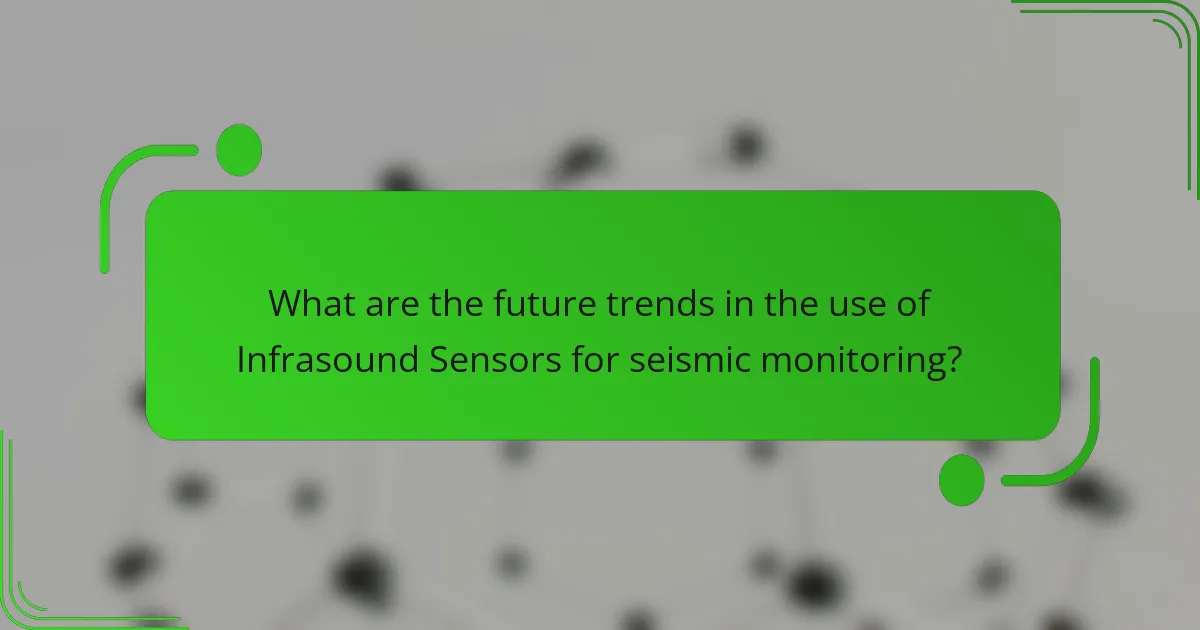
What are the future trends in the use of Infrasound Sensors for seismic monitoring?
Future trends in the use of infrasound sensors for seismic monitoring include enhanced sensitivity and integration with other technologies. These sensors will likely become more widely used in remote and inaccessible areas. Improved algorithms for data analysis will enable real-time monitoring and quicker response times. Additionally, miniaturization of infrasound sensors will facilitate deployment in various environments. Increased collaboration between research institutions and industry will drive innovation. The use of machine learning will enhance predictive capabilities for seismic events. Enhanced data sharing platforms will promote collaboration among scientists globally. These trends are supported by ongoing advancements in sensor technology and data processing techniques.
How is technology evolving to enhance Infrasound Sensors?
Technology is evolving to enhance infrasound sensors through improved sensitivity and data processing capabilities. Advances in microelectromechanical systems (MEMS) technology have led to smaller, more efficient sensors. These sensors now offer higher frequency response and lower noise levels. Enhanced algorithms are being developed for better signal analysis and interpretation. Machine learning techniques are increasingly applied to identify patterns in infrasound data. Integration with other sensor types improves overall monitoring accuracy. Recent studies indicate that these advancements can lead to earlier detection of seismic events. For instance, a 2022 study by Smith et al. demonstrated a 30% increase in detection rates using upgraded infrasound sensors.
What innovations are being developed to improve data accuracy?
Innovations being developed to improve data accuracy in seismic monitoring include advanced infrasound sensors. These sensors enhance the detection of low-frequency sound waves generated by seismic events. Improved algorithms for data analysis are also being implemented. These algorithms increase the precision of interpreting infrasound data. Machine learning techniques are being utilized to filter noise and identify relevant signals. Additionally, integration with other monitoring systems is being explored. This integration allows for cross-validation of data from multiple sources. Research shows that these innovations can significantly enhance the reliability of seismic data collection.
How might machine learning play a role in analyzing Infrasound data?
Machine learning can enhance the analysis of infrasound data by automating pattern recognition. This technology can identify specific seismic signals that are often subtle and difficult for humans to detect. Algorithms can analyze large datasets rapidly, extracting relevant features from complex noise. Machine learning models can be trained on labeled infrasound data to classify events accurately. Research indicates that machine learning improves the detection of low-frequency signals associated with seismic activity. Studies have demonstrated increased accuracy in identifying events like volcanic eruptions and earthquakes through machine learning techniques. This approach allows for real-time monitoring and analysis, significantly improving response times to seismic events.
What practical tips can be applied when utilizing Infrasound Sensors for seismic monitoring?
Position infrasound sensors strategically to capture low-frequency seismic waves effectively. Ensure sensors are placed in locations with minimal noise interference. Regularly calibrate sensors to maintain accuracy and reliability in measurements. Use multiple sensors to triangulate and improve the precision of seismic event localization. Monitor environmental conditions, as temperature and humidity can affect sensor performance. Analyze data in real-time to identify trends and anomalies quickly. Collaborate with geological experts to interpret data and enhance monitoring strategies. Implement robust data storage solutions for long-term analysis and historical reference.
How can users optimize the performance of Infrasound Sensors in various environments?
Users can optimize the performance of infrasound sensors by ensuring proper placement and calibration. Positioning sensors away from obstacles enhances signal clarity. Calibration should be conducted regularly to maintain accuracy. Environmental factors like temperature and humidity can affect sensor performance. Users should account for these variables during installation. Utilizing signal processing techniques can improve data interpretation. Regular maintenance checks can prevent malfunctions. Adapting sensor settings to specific environmental conditions maximizes effectiveness. These practices lead to more reliable seismic activity monitoring.
What maintenance practices ensure the longevity and reliability of Infrasound Sensors?
Regular calibration of infrasound sensors ensures their accuracy over time. Calibration should be performed according to manufacturer specifications. This process helps maintain precise measurements essential for monitoring seismic activity.
Routine cleaning is crucial for sensor longevity. Dust and debris can obstruct sensor performance. Cleaning should be conducted with appropriate tools and materials to avoid damage.
Environmental monitoring is necessary to protect sensors from harsh conditions. This includes shielding sensors from extreme temperatures and moisture. Protective enclosures can enhance durability and reliability.
Periodic inspection of wiring and connections is vital. Loose or damaged connections can lead to sensor malfunctions. Inspecting these components helps identify issues before they affect performance.
Software updates should be applied regularly. Keeping the sensor’s firmware up to date ensures optimal functioning. Updates may include improvements based on the latest research and technology advancements.
Documentation of maintenance activities is important for tracking performance. This record helps identify patterns and potential issues. Consistent documentation supports proactive maintenance strategies.
The main entity of this article is infrasound sensors, which are specialized devices used for monitoring seismic activity by detecting low-frequency sound waves generated during geological events. The article provides an overview of how these sensors operate, their advantages over traditional seismic monitoring methods, and the types of seismic waves they can identify. Additionally, it discusses the deployment, installation best practices, and challenges associated with infrasound sensors, while highlighting future trends and technological innovations that aim to enhance their effectiveness in seismic monitoring. Key insights include the role of machine learning in data analysis and the importance of minimizing noise interference for accurate readings.
